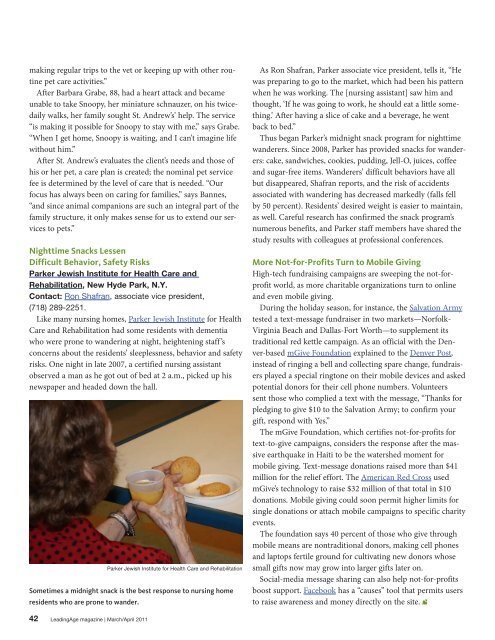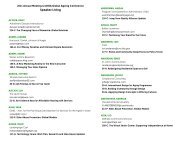The Anatomy of Change The Anatomy of Change - LeadingAge
The Anatomy of Change The Anatomy of Change - LeadingAge
The Anatomy of Change The Anatomy of Change - LeadingAge
Create successful ePaper yourself
Turn your PDF publications into a flip-book with our unique Google optimized e-Paper software.
making regular trips to the vet or keeping up with other routine<br />
pet care activities.”<br />
After Barbara Grabe, 88, had a heart attack and became<br />
unable to take Snoopy, her miniature schnauzer, on his twicedaily<br />
walks, her family sought St. Andrew’s’ help. <strong>The</strong> service<br />
“is making it possible for Snoopy to stay with me,” says Grabe.<br />
“When I get home, Snoopy is waiting, and I can’t imagine life<br />
without him.”<br />
After St. Andrew’s evaluates the client’s needs and those <strong>of</strong><br />
his or her pet, a care plan is created; the nominal pet service<br />
fee is determined by the level <strong>of</strong> care that is needed. “Our<br />
focus has always been on caring for families,” says Bannes,<br />
“and since animal companions are such an integral part <strong>of</strong> the<br />
family structure, it only makes sense for us to extend our services<br />
to pets.”<br />
Nighttime Snacks Lessen<br />
Difficult Behavior, Safety Risks<br />
Parker Jewish Institute for Health Care and<br />
Rehabilitation, New Hyde Park, N.Y.<br />
Contact: Ron Shafran, associate vice president,<br />
(718) 289-2251.<br />
Like many nursing homes, Parker Jewish Institute for Health<br />
Care and Rehabilitation had some residents with dementia<br />
who were prone to wandering at night, heightening staff’s<br />
concerns about the residents’ sleeplessness, behavior and safety<br />
risks. One night in late 2007, a certified nursing assistant<br />
observed a man as he got out <strong>of</strong> bed at 2 a.m., picked up his<br />
newspaper and headed down the hall.<br />
Sometimes a midnight snack is the best response to nursing home<br />
residents who are prone to wander.<br />
42 <strong>LeadingAge</strong> magazine | March/April 2011<br />
Parker Jewish Institute for Health Care and Rehabilitation<br />
As Ron Shafran, Parker associate vice president, tells it, “He<br />
was preparing to go to the market, which had been his pattern<br />
when he was working. <strong>The</strong> [nursing assistant] saw him and<br />
thought, ‘If he was going to work, he should eat a little something.’<br />
After having a slice <strong>of</strong> cake and a beverage, he went<br />
back to bed.”<br />
Thus began Parker’s midnight snack program for nighttime<br />
wanderers. Since 2008, Parker has provided snacks for wanderers:<br />
cake, sandwiches, cookies, pudding, Jell-O, juices, c<strong>of</strong>fee<br />
and sugar-free items. Wanderers’ difficult behaviors have all<br />
but disappeared, Shafran reports, and the risk <strong>of</strong> accidents<br />
associated with wandering has decreased markedly (falls fell<br />
by 50 percent). Residents’ desired weight is easier to maintain,<br />
as well. Careful research has confirmed the snack program’s<br />
numerous benefits, and Parker staff members have shared the<br />
study results with colleagues at pr<strong>of</strong>essional conferences.<br />
More Not-for-Pr<strong>of</strong>its Turn to Mobile Giving<br />
High-tech fundraising campaigns are sweeping the not-forpr<strong>of</strong>it<br />
world, as more charitable organizations turn to online<br />
and even mobile giving.<br />
During the holiday season, for instance, the Salvation Army<br />
tested a text-message fundraiser in two markets—Norfolk-<br />
Virginia Beach and Dallas-Fort Worth—to supplement its<br />
traditional red kettle campaign. As an <strong>of</strong>ficial with the Denver-based<br />
mGive Foundation explained to the Denver Post,<br />
instead <strong>of</strong> ringing a bell and collecting spare change, fundraisers<br />
played a special ringtone on their mobile devices and asked<br />
potential donors for their cell phone numbers. Volunteers<br />
sent those who complied a text with the message, “Thanks for<br />
pledging to give $10 to the Salvation Army; to confirm your<br />
gift, respond with Yes.”<br />
<strong>The</strong> mGive Foundation, which certifies not-for-pr<strong>of</strong>its for<br />
text-to-give campaigns, considers the response after the massive<br />
earthquake in Haiti to be the watershed moment for<br />
mobile giving. Text-message donations raised more than $41<br />
million for the relief effort. <strong>The</strong> American Red Cross used<br />
mGive’s technology to raise $32 million <strong>of</strong> that total in $10<br />
donations. Mobile giving could soon permit higher limits for<br />
single donations or attach mobile campaigns to specific charity<br />
events.<br />
<strong>The</strong> foundation says 40 percent <strong>of</strong> those who give through<br />
mobile means are nontraditional donors, making cell phones<br />
and laptops fertile ground for cultivating new donors whose<br />
small gifts now may grow into larger gifts later on.<br />
Social-media message sharing can also help not-for-pr<strong>of</strong>its<br />
boost support. Facebook has a “causes” tool that permits users<br />
to raise awareness and money directly on the site.



